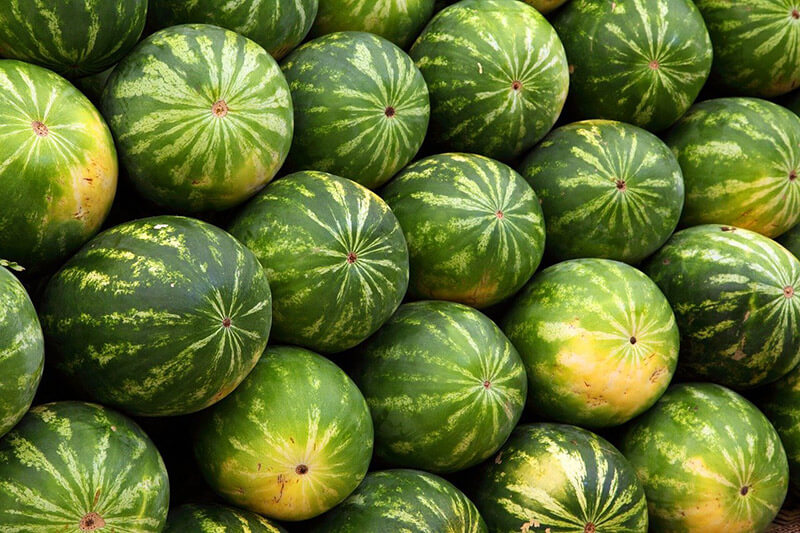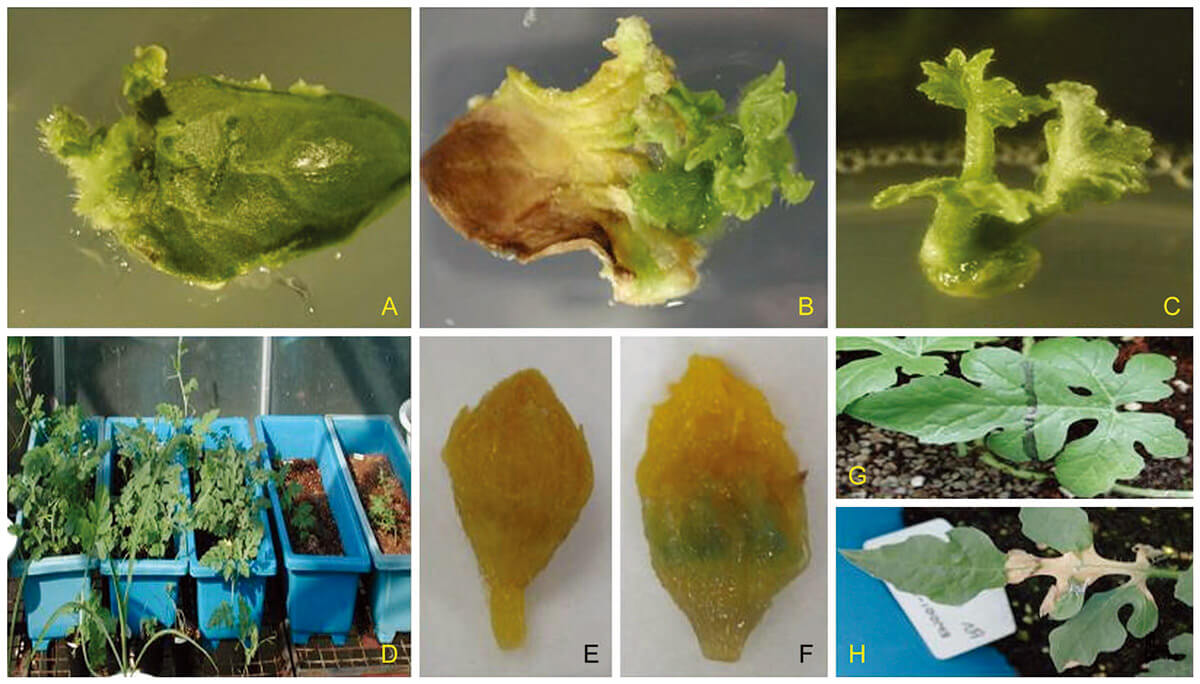Citrullus lanatus (Thunb.) Matsum & Nakai, also known as watermelon, is an annual trailing vine of the Cucurbitaceae family. It has large fruits, nearly spherical or oval, and is cultivated all over the world. Watermelon is called the "king of midsummer". It is thirst-quenching, sweet and juicy. Watermelon does not contain fat and cholesterol, while contains a lot of glucose, malic acid, fructose, protein amino acids, lycopene and rich vitamin C. In order to further increase the yield of watermelon and enrich its nutritional value, Citrullus lanatus (Thunb.) Matsum & Nakai gene editing has been widely used.Through genetic modifications, we can improve Citrullus lanatus (Thunb.) Matsum & Nakai's disease resistance, insect resistance, drought resistance, fruit size, etc.

Lifeasible provides one-stop services, covering all steps including experimental design, vector construction, plasmid transformation, positive transplant screening and characterization of transgenic Citrullus lanatus (Thunb.) Matsum & Nakai, our various genetic modification services are as follows:
Gene overexpression is an efficient tool for studying gene function. The development and utilization of gene overexpression technology has brought us many conveniences to study gene function and improving the yield of target products. Through the quantitative overexpression of genes related to glucose, malic acid, fructose and other chemical components in Citrullus lanatus (Thunb.) Matsum & Nakai, the production of specific compounds can be increased. We could help our customer overexpress many genes including gene Cllcyb-177 that affects the color of watermelon pulp, meiosis key gene SPO11-1, low temperature tolerance gene CIWRKY20, AT1G32630, gray mold resistance gene XBCI33, drought resistance and salt tolerance gene CIP5CS, and many other genes related to important traits of Citrullus lanatus (Thunb.) Matsum & Nakai.
RNAi technology is widely used in the field of gene engineering, it is a phenomenon of specific gene silencing mediated by double-stranded RNA (dsRNA) and involved in specific enzymes. It blocks gene expression at the transcription level and translation level. Through RNAi technology, we can achieve silencing of multiple genes in Citrullus lanatus (Thunb.) Matsum & Nakai.
Virus induced gene silencing (VIGS) is a genetic technology that inhibits the expression of endogenous genes in plants by inserting recombinant viruses into target gene segments, they can induce plant endogenous gene silencing and cause phenotypic changes, and then study the function of target genes based on phenotypic changes. The VIGS technology is a method of transient transformation and underlying molecular basis may be post-transcriptional gene silencing. Silencing and functional analysis of target genes in Citrullus lanatus (Thunb.) Matsum & Nakai through VIGS can help our customers save time and obtain valuable information for gene functional analysis. With wealth of experience in VIGS, our scientists can provide you with customized protocol for VIGS in Citrullus lanatus (Thunb.) Matsum & Nakai.
CRISPR gene knockout technology is currently the most widely used gene knockout technology, it provides us with a very powerful and convenient gene editing tool. As a leading company that has been deeply involved in the field of gene editing for many years, through the CRISPR technology, we can knockout Citrullus lanatus (Thunb.) Matsum & Nakai genes in different ways, including frameshift mutations, multiple deletion of fragments, knockout of non-coding genes, knockout of multiple copies of genes, etc.
CRISPR system has strong scalability, and this scalability can be used to develop more useful gene editing tools. we have developed many methods that can improve gene knock-in efficiency and achieve precise editing of the Citrullus lanatus (Thunb.) Matsum & Nakai genome.
CRISPR single base editing technology is a hot area of life science research today. As a company that has been cultivating gene editing technology for decades, Lifeasible could help you achieve the conversion from C to T or A to G in Citrullus lanatus (Thunb.) Matsum & Nakai using CBE and ABE, both of which rely on the fusion of dCAS9 to a specific deaminase. During single base editing, the C base deaminase or A base deaminase is located at a specific position in the genome, catalyzing the deamination reaction of C or A at a specific position and turns it into U or I. Then it is treated as T or G in the process of DNA replication, realizing the conversion from C to T or A to G.
Sequence-specific control of gene expression on a genome-wide scale is an important approach for understanding gene functions and for engineering genetic regulatory systems, One of them is CRISPR Interference (CRISPRi). There are many ways to participate in the inhibition of gene expression. For the inhibition of Citrullus lanatus (Thunb.) Matsum & Nakai genes, we can provide a variety of solutions, including dCas9 binding to targeted DNA and realizing Inhibition of gene transcription through steric hindrance. In addition, gene knockdown can also be achieved by recruiting a fusion protein to the start site of gene transcription.
CRISPRa technology uses the powerful capabilities of Cas9 and sgRNA to fuse or recruit multiple proteins to enhance gene transcription. For Citrullus lanatus (Thunb.) Matsum & Nakai genes, we provide VPR technology, SAM technology and Suntag technology to allow the CRISPR system to carry more activation element and achieve a stronger activation effect after synergistic amplification.
The study of gene function has always been the core subject of biological research. The earliest genetic screening system established through forward genetics is very inefficient and has a huge workload. However, the reverse genetic screening system based on CRISPR technology can complete very low-cost mutation library construction work. The gene mutation library construction technology we provide for Citrullus lanatus (Thunb.) Matsum & Nakai including gene knockout library construction, gene knockdown library construction, and gene activation library construction. Moreover, single-cell sequencing is available for mutation screening.
DNA-free gene editing technology has received extensive attention from the industry in recent years. We provide DNA free Citrullus lanatus (Thunb.) Matsum & Nakai genome editing services, including transient expression of CRISPR/Cas9 plasmid DNA, in vitro transcription of CRISPR/Cas9, and pre-assembled ribonucleic acid composed of purified Cas9 protein and sgRNAs complex. These technologies can avoid the integration of foreign DNA and genome, and reduce off-target effects. In addition, compared with traditional techniques, these techniques can avoid the use of hybridization or backcrossing to isolate CRISPR/Cas9 chimeras, so they are cheaper and have shorter experimental cycles.
Genetic Transformation Process for Citrullus lanatus (Thunb.) Matsum & Nakai
Until today, The most advanced and widely used method for the development of genetically modified Citrullus lanatus (Thunb.) Matsum & Nakai is Agrobacterium-mediated cotyledonary transformation. Briefly, after the infection of Agrobacterium, the foreign target gene is transferred and integrated into cotyledonary explants, and then transformed plants are regenerated through tissue culture.
 Figure 1. Plant infection and regeneration from cotyledonary explants of watermelon mediated by Agrobacterium. (A, B, C) Adventitious shoots formation on shoot induction medium with 5 mg dm-3 glufosinate, (D) Transgenic watermelon grown in soil, (E) GUS negative response in flower of non-transgenic plant, (F) GUS positive response in flower of transgenic plant, (G) Herbicide-resistance response in the leaf of transgenic leaf, (H) Necrosis in leaf of nontransgenic plant with Basta treatment. (Cho MA, et al. 2008)
Figure 1. Plant infection and regeneration from cotyledonary explants of watermelon mediated by Agrobacterium. (A, B, C) Adventitious shoots formation on shoot induction medium with 5 mg dm-3 glufosinate, (D) Transgenic watermelon grown in soil, (E) GUS negative response in flower of non-transgenic plant, (F) GUS positive response in flower of transgenic plant, (G) Herbicide-resistance response in the leaf of transgenic leaf, (H) Necrosis in leaf of nontransgenic plant with Basta treatment. (Cho MA, et al. 2008)
Experts at Lifeasible obtain comprehensive knowledge and years of experience to solve technical problems and challenges in Citrullus lanatus (Thunb.) Matsum & Nakai transformation. We can draw customized solution to help you research on a variety of Citrullus lanatus (Thunb.) Matsum & Nakai genes. For more information or any inquiry requirements, please contact Lifeasible.
Reference